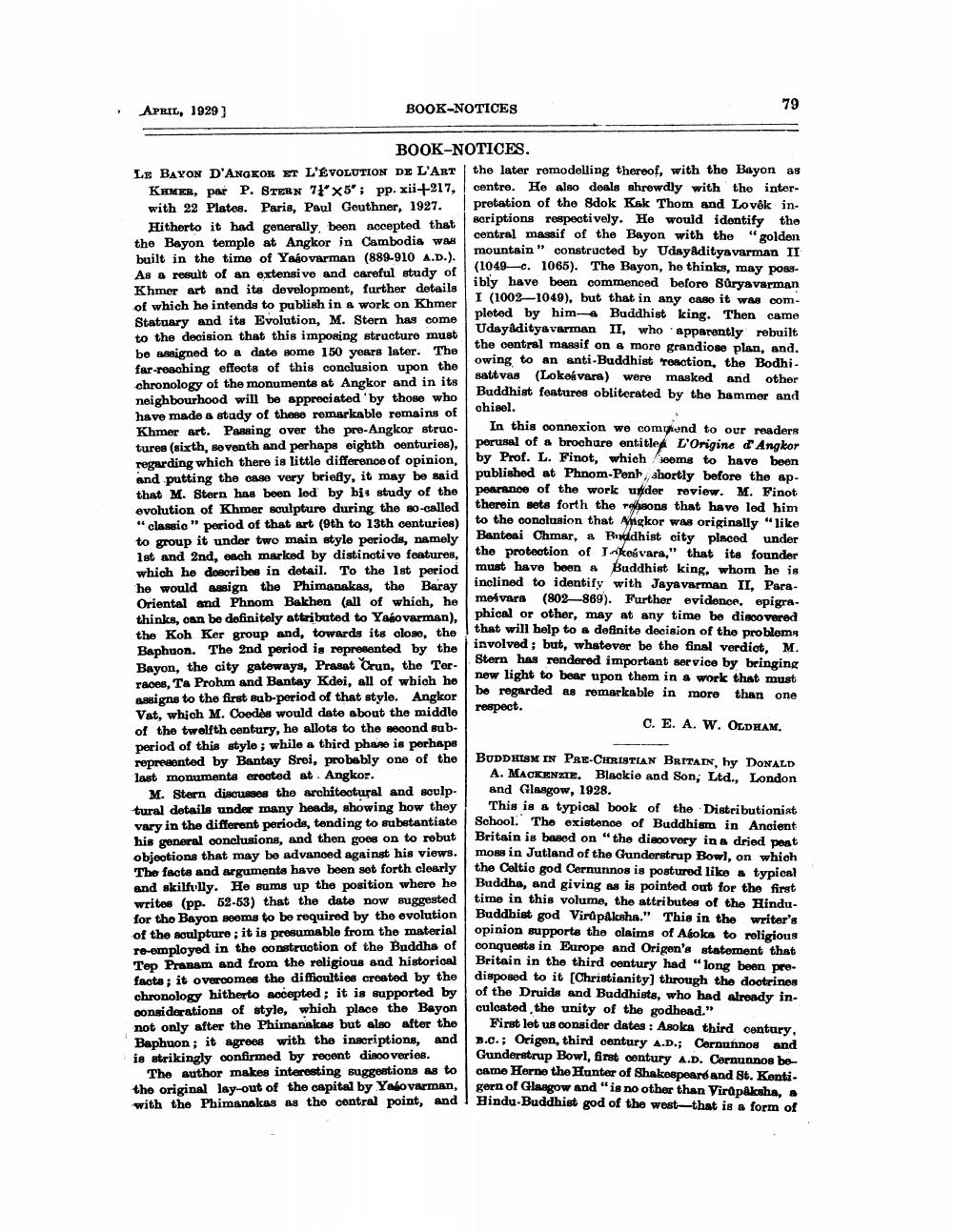________________
APRIL, 1929]
BOOK-NOTICES
BOOK-NOTICES.
LE BAYON D'ANGKOR ET L'ÉVOLUTION DE L'ART KHMER, par P. STERN 71x5"; pp. xii+217, with 22 Plates. Paris, Paul Geuthner, 1927. Hitherto it had generally, been accepted that the Bayon temple at Angkor in Cambodia was built in the time of Yasovarman (889-910 A.D.). As a result of an extensive and careful study of
Khmer art and its development, further details
of which he intends to publish in a work on Khmer Statuary and its Evolution, M. Stern has come to the decision that this imposing structure must be assigned to a date some 150 years later. The far-reaching effects of this conclusion upon the chronology of the monuments at Angkor and in its neighbourhood will be appreciated by those who have made a study of these remarkable remains of Khmer art. Passing over the pre-Angkor structures (sixth, seventh and perhaps eighth centuries), regarding which there is little difference of opinion, and putting the case very briefly, it may be said that M. Stern has been led by his study of the evolution of Khmer sculpture during the so-called "classic" period of that art (9th to 13th centuries) to group it under two main style periods, namely 1st and 2nd, each marked by distinctive features, which he describes in detail. To the 1st period he would assign the Phimanakas, the Baray Oriental and Phnom Bakhen (all of which, he thinks, can be definitely attributed to Yaéovarman), the Koh Ker group and, towards its close, the Baphuon. The 2nd period is represented by the Bayon, the city gateways, Prasat Crun, the Terraces, Ta Prohm and Bantay Kdei, all of which he assigns to the first sub-period of that style. Angkor Vat, which M. Coedès would date about the middle of the twelfth century, he allots to the second subperiod of this style; while a third phase is perhaps represented by Bantay Srei, probably one of the last monuments erected at. Angkor.
M. Stern discusses the architectural and sculp. tural details under many heads, showing how they vary in the different periods, tending to substantiate his general conclusions, and then goes on to rebut objections that may be advanced against his views. The facts and arguments have been set forth clearly and skilfully. He sums up the position where he writes (pp. 52-53) that the date now suggested for the Bayon seems to be required by the evolution of the sculpture; it is presumable from the material re-employed in the construction of the Buddha of Tep Pranam and from the religious and historical facts; it overcomes the difficulties created by the chronology hitherto accepted; it is supported by considerations of style, which place the Bayon not only after the Phimanakas but also after the Baphuon; it agrees with the inscriptions, and is strikingly confirmed by recent discoveries.
The author makes interesting suggestions as to the original lay-out of the capital by Yaso varman, with the Phimanakas as the central point, and
79
the later remodelling thereof, with the Bayon as centre. He also deals shrewdly with the interpretation of the Sdok Kak Thom and Lovêk inscriptions respectively. He would identify the central massif of the Bayon with the "golden mountain" constructed by Udayadityavarman II (1049 c. 1065). The Bayon, he thinks, may possibly have been commenced before Suryavarman I (1002-1049), but that in any case it was completed by him a Buddhist king. Then came Udayadityavarman II, who apparently rebuilt the central massif on a more grandiose plan, and. owing to an anti-Buddhist reaction, the Bodhi. sattvas (Loke vara) were masked and other Buddhist features obliterated by the hammer and chisel.
In this connexion we commend to our readers perusal of a brochure entitled L'Origine d'Angkor by Prof. L. Finot, which seems to have been published at Phnom Penh shortly before the appearance of the work under review. M. Finot therein sets forth the reasons that have led him to the conclusion that Angkor was originally "like Banteai Chmar, a Buddhist city placed under the protection of Ikesvara," that its founder must have been a Buddhist king, whom he is inclined to identify with Jayavarman II, Paramesvara (802-869). Further evidence, epigraphical or other, may at any time be discovered that will help to a definite decision of the problems involved; but, whatever be the final verdict, M. Stern has rendered important service by bringing new light to bear upon them in a work that must be regarded as remarkable in more than one respect.
C. E. A. W. OLDHAM.
BUDDHISM IN PRE-CHRISTIAN BRITAIN, by DONALD A. MACKENZIE. Blackie and Son, Ltd., London and Glasgow, 1928.
This is a typical book of the Distributionist School. The existence of Buddhism in Ancient Britain is based on "the discovery in a dried peat moss in Jutland of the Gunderstrup Bowl, on which the Celtic god Cernunnos is postured like a typical Buddha, and giving as is pointed out for the first time in this volume, the attributes of the HinduBuddhist god Virupaksha." This in the writer's opinion supports the claims of Atoka to religious conquests in Europe and Origen's statement that Britain in the third century had "long been predisposed to it [Christianity] through the doctrines of the Druids and Buddhists, who had already inculcated the unity of the godhead."
First let us consider dates: Asoka third century, B.C.; Origen, third century A.D.; Cernunnos and Gunderstrup Bowl, first century A.D. Cernunnos became Herne the Hunter of Shakespeare and St. Kentigern of Glasgow and "is no other than Virupaksha, a Hindu-Buddhist god of the west-that is a form of




